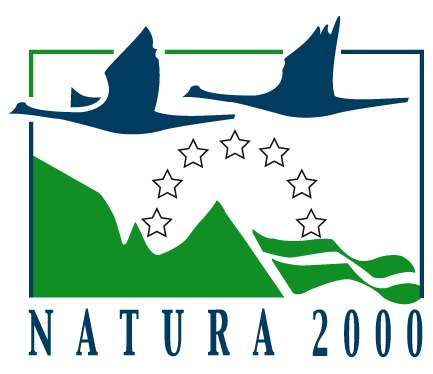


Lesser White-fronted Goose (Anser erythropus)
The LWfG is a brownish goose somewhat smaller than the other large-bodied geese. Its geographic distribution is Palearctic, and it breeds in the tundra zone near the Arctic Circle from northern Fenno-Scandinavia to eastern Siberia. The nesting habitat is typically low-lying, open or wooded tundra dominated by dwarf shrubs, and its typical feeding habitat is sedge marshes/mires or sedge-grown edges of lakes. On migration, the species prefers low-growth salt marshes or coastal meadows (e.g. in northern Norway, western Finland, Estonia) and natural or semi-natural steppes (e.g. in Hungary). Due to the transformation of much of the original, natural staging and wintering habitats in the southern parts of the range, the main feeding grounds can now be found principally in agricultural areas.
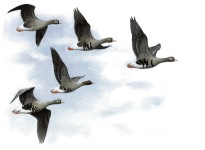
Lesser White-fronted Goose (second from bottom) in a flock of
the very similar
Greater White-fronted Goose (© Jari Kostet)
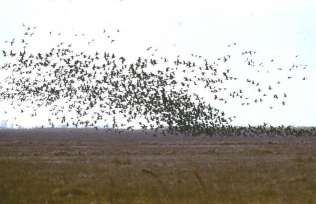
A goose flock in the
Hortobágy steppe
(© dr. Gábor Kovács)
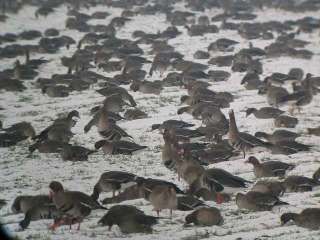
Goose flock on a
snowy field
(© Attila Szilágyi)
Migration and conservation
On autumn passage, more than half of the Fennoscandian LWfG breeding population follows the European migration route via the Baltic states to Hungary, and further south to the wintering grounds in northern Greece and north-western Turkey (e.g. the Evros Delta area). The present project is focussing on the conservation of the population following the European flyway, which is the only route in the world that is entirely known from the breeding to the wintering sites.
Lesser White-fronted Geese usually arrive from their breeding grounds in Hungary in mid-September and leave for their wintering sites in Greece and Turkey in November, but in mild weather they may also overwinter here. On their return migration, they arrive in March and stay in Hungary until April. Overall, the Fennoscandian LWfG population spends a quarter of a year (ca. one month in spring and two months in autumn) in Hungary. Most records of the species in Hungary are from the Hortobágy region, although the species is also regularly observed in Biharugra, Kardoskút and near Lake Fertő.
The Lesser White-fronted Goose is the only arctic goose species with a declining population and and is in an endangered conservation status. Contrary to all other arctic goose species regularly occurring in Western Europe and migrating mostly in a south-western direction, the general migration direction of the western LWfG populations is south/south-east, and the wintering sites are mainly located in eastern Europe and in the Black Sea/Caspian Sea region. In these areas, the control of hunting as well as the conservation of wetlands is less advanced than in Western Europe, and this is one of the most important reasons for the endangered status of the LWfG, while practically all other arctic goose populations wintering in western Europe are thriving. Results of research on LWfG suggest that the most significant element of population decline is the mortality of adult birds, caused directly by hunting and poaching.
The species is included in Annex I of the Birds Directive (79/409/EEC). In 1996, European Commission adopted an international Action Plan for the Lesser White-fronted Goose, in which locating and assessing key areas is ranked as the highest conservation priority (essential). Other high priorities listed in the plan are to promote the legal protection of the species and the key staging sites, to reduce hunting pressure, to manage and prevent further losses of habitats in the staging and wintering grounds, are listed as high priority actions in the international action plan.
The present project aims to carry out the conservation actions prioritised in the international Action Plan along the European flyway of the species. A LIFE-Nature project aiming the protection of LWfG was implemented in Finland between 1997 and 2002 (LIFE97NAT/FIN/4098), which provided essential information on the species and its migration, provided protection for the Finnish staging sites and active habitat management and monitoring were initiated. The Finnish (WWF Finland) and the Norwegian (BirdLife Norway) action groups have been co-operating since 1994 to explore and conserve staging and wintering sites. As part of this programme, ringing and satellite tracking of LWfG populations breeding in Fennoscandia, the Yamal Peninsula (western Siberia) and the Taymyr Peninsula (Central Siberia) were carried out.
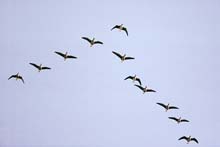
A flock of Lesser
White-fronted Geese
(© Petteri Tolvanen)
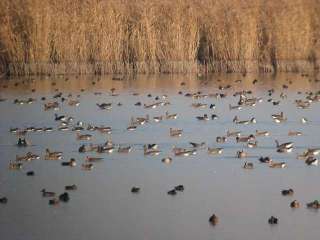
Goose flock on a fishpond
(© Attila Szilágyi)
Conservation status
The Lesser White-fronted Goose is a globally threatened species and is listed in the most threatened category (Critically Endangered, CR) of the IUCN (International Union for the Conservation of Nature). The species is strictly protected in Hungary, with a conservation value of 500,000 HuF. The historical range of the Lesser White-fronted Goose covers the whole subarctic Eurasia, but nowadays the distribution is patchy. The recent estimate of the mid-winter world population of the LWfG is 22,000-27,000 individuals. The world population is (also genetically) divided into two parts, a western and an eastern flyway population, with a geographic divide on the Taymyr Peninsula area in northern central Siberia. The wild Fennoscandian breeding population, which is substantially isolated from the western populations both geographically and genetically, is currently estimated at only 20-30 breeding pairs, with an unknown number (but certainly less than 10) pairs breeding on the Kola Peninsula in Russia.
All LWfG populations show a declining trend. In Fennoscandia, the average rate of the annual decline in recent years has been estimated at 5 %. This decrease is apparent at the migration sites as well; while flocks of thousands of Lesser White-fronted Geese regularly occurred in the 1960s and 70s, the maximum annual numbers in the past few years were between 30 and 40 individuals, and never exceeded 60.
The Fennoscandian population is already so small that it is on the brink of extinction. Unforeseen events, such as many subsequent years of unfavourable weather may cause the extinction of the entire Fennoscandian population. Therefore, urgent actions are necessary to ensure a more effective protection.

A pair of Lesser
White-fronted Geese
(© Ari Leinonen)
Threats
1. High mortality due to hunting and poaching
Although LWfG is legally protected in all countries in its geographic range (except for Azerbaijan and China), the rate of mortality due to hunting and poaching is estimated at up to 30-50%, based on the monitoring of marked individuals. The real situation, however, is probably even worse, because most of the mortality due to hunting remains unknown. As a result, although the breeding success (juvenile production) of the Fennoscandian LWfG population is not lower than that in other arctic goose species, the population is continuously and rapidly declining.
2. Habitat loss in migration and wintering sites
In recent decades, a significant loss of habitats has occurred in the staging and wintering grounds of the species. Feeding conditions along the migration route and in wintering areas have deteriorated due to the transformation of the natural steppes (original feeding sites) into cultivated land, and many wetlands (roosting sites) have been drained or degraded, which have forced LWfG to use sub-optimal and less safe areas for feeding and roosting.
3. Human disturbance
Human activities such as traffic and tourism (e.g. fishing, bird watching), agriculture, and hunting scare the geese, and force them to leave their preferred habitats, which results in less time available for feeding or feeding in sub-optimal habitats, eventually leading to lower rates of energy intake, which is essential during migration. When scared by human activities, LWfG may also fly to or through areas where hunting pressure is high. Frequent disturbance may thus result in poor body condition and higher risks of mortality due to hunting/poaching.
4. Lack of knowledge
The LWfG has become extremely rare, and is consequentially a poorly known species. For example, we still lack basic knowledge regarding the migration routes, the staging and wintering sites, the protection status of sites, and the behaviour and social system of the species. There is clearly a need for further conservation research and monitoring.
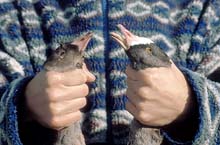
Juvenile and adult LWfG perished due to poaching in the Kostanay region of northern Kazakhstan
(© Petteri Tolvanen)